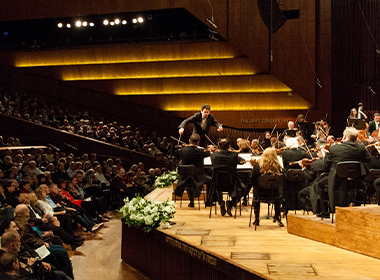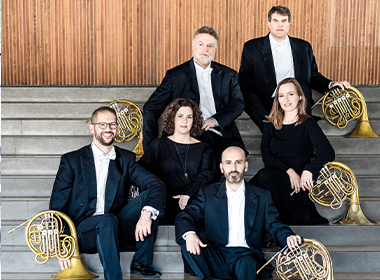The Israel Philharmonic Orchestra is proud to present the first in a series of concerts performed and conducted by Sir András Schiff, the first musician to be appointed Artist-in-Residence of the orchestra.
Schiff, one of the major musicians of our time, is a pianist, conductor, researcher and theorist of music. He offers the audience a new, refreshing and deep perspective of the musical works in which he specializes, including cycles of works by Bach, Mozart, Beethoven and Schumann.
The concerts and recital he will perform this season with the IPO will be dedicated to works by Ludwig van Beethoven, celebrating his 250th anniversary.
Piano Concerto no. 2
1795. Vienna. The local Composers League polishes the Burgtheater in preparation for the annual fundraising concert for local musicians, their widows and their orphans. The centerpiece of the concert is a new work by the groundbreaking young composer Ludwig Van Beethoven, who will also conduct the entire concert. At the time (two days before the concert), four miserable copyists sit and receive from the feverish composer page after page of the Concerto’s finale (Rondo). They must prepare the orchestra parts overnight, and pray that the composer does not get writer’s block at the very last moment. All’s well that ends well: Beethoven and his copyists completed the task, the work was performed on time and was a great success. Up to the time of its publication it underwent a series of editing and rewriting.
If one thinks about it, nothing in the history of this Concerto is as it seems. Firstly, Beethoven’s Piano Concerto no. 2 is actually the first piano concerto written by the mature composer (the young Beethoven wrote a piano concerto in E-flat major when he was only 13!), but it was published after the C major Concerto (no. 1). The third movement that we will hear in these concerts is not the one written hastily for the premiere (the original movement was later published as Rondo in B-flat major for Piano and Orchestra).
And the second movement? In 1807 Beethoven wrote to his publisher: “As is so often the case with me, I did not write the piano part in the score (for previous performances), so you’ll have to receive it now in my illegible handwriting”. We can only assume that what we know today as the wonderful second movement is merely a “formal” version of the movement, whose piano part was improvised by Beethoven at the premiere.
Should this expedition into the work’s compositional process change the way we listen to it? Of course not. The work is written for a smaller orchestra than in Beethoven’s later piano concertos (this is the only concerto without timpani). The work may be less “dramatic” than the C major Concerto and it may contain certain elements that resemble Mozart’s style more than the mature Beethoven, who was an innovator structurally and stylistically in his last three concertos. However, Beethoven’s personal stylistic stamp is unmistakable here, in the harmonic writing, in the lyricism of the second movement, in the sophistication of the rondo theme and in the sensible organization of the last movement.
Piano Concerto no. 3
If the second piano concerto supplied the “collectors of historical gossip” the characters of Beethoven’s tortured copyists, then the Third Piano Concerto presented a new figure – the page-turner. Not just a random one, but conductor Ignaz von Seifert, who volunteered to help at the concerto’s premiere in 1803. Seifert wrote in his memoirs: “I saw almost nothing but empty leaves; at the most, on one page or another a few Egyptian hieroglyphs, wholly unintelligible to me were scribbled down to serve as clues for him; for he played nearly all of the solo part from memory since, as was so often the case, he had not had time to set it all down on paper. He gave me a secret glance whenever he was at the end of one of the invisible passages, and my scarcely concealable anxiety not to miss the decisive moment amused him greatly and he laughed heartily at the jovial supper which we ate afterwards.”
This account is interesting, since the composition of the C-minor Concerto took seven years. Beethoven already began jotting down ideas for the Concerto in 1796 and finished the score only in 1803. Truth be told, Beethoven actually finished writing the Concerto with the cadenza in 1809 (in previous instances the composer probably improvised a cadenza). However, one can assume that the Concerto was written primarily to serve Beethoven’s needs as a pianist, and we inevitably learn from it not only about the composer’s mood, but also about his pianistic concept, as well as about the features of the instrument (whose register was widely expanded at the time). The C minor concerto is considered a pioneering work, and the moment in which the independent Beethovenian style of piano concerto writing was born.
The IPO audiences will be interested to place this concerto in an historical and musical context in relation to the two piano concertos performed lately in the subscription series. I am certain that Tamara Stefanovich’s unique rendition of Mozart’s C minor Concerto no. 24, K. 491 still resounds in our ears. We know that Beethoven was inspired by this Concerto (and the readers are invited to choose their favorite anecdote, in the lines of “Beethoven was walking down the street when he suddenly heard Mozart’s Concerto being played, he gripped the arm of his friend and said, ‘Is there music more beautiful than this?’”). Not only the choice of key and the thematic similarity, but also elements of Mozartian orchestral writing found their way into Beethoven’s Concerto. But I wish to point out a connection between the wonderful writing for solo winds in the second movement of this Concerto (the flute and bassoon play solo melodies, which are accompanied subtly by the piano) and Ravel’s Piano Concerto in G, which was lately played by Martha Argerich. I have no doubt that the inspiration that Beethoven gave to Ravel was of the same kind that Beethoven received from Mozart’s C-minor Concerto.
Coriolan Overture
A riddle: who has heard of the playwright Joachim von Collin? (How could you not have heard of him? The man was the Imperial Secretary in Vienna!) And what about Prince Lobkowitz? And Prince Lichnowsky? I assume that the only reason that these people’s names are mentioned now is the fact that they are connected in some way with Beethoven’s short and highly effective work – the Coriolan(us) Overture. Beethoven wrote the music to a play of the same name written by Collin (who was also a friend of the composer). The play, if we are to be kind, was not the best work, and did not gain great success. The premieres used music by Mozart (quotes from Idomeneo), but one performance (the last one!), from April 1807, used Beethoven’s music.
The Overture is undoubtedly Beethoven’s. It is powerful, emotional, abounding in heroism, with touches of sensitive lyricism. The work realizes the orchestral ability to create an intense sound, and at given moments one can see the uniqueness of Beethoven’s orchestral language (for example, the moment in which two bassoons double the line played by the cellos). Coriolan’s Beethoven is concise, and the “release” from larger forms proves once again that his music can flourish in our times, in which attention spans are constantly getting shorter.
The Creatures of Prometheus Overture
If there were to be a competition called “How to enjoy and understand Beethoven’s musical language without having to invest more than five minutes in it”, then The Creatures of Prometheus Overture would undoubtedly win it. This short work seemingly has everything: a dramatic opening (of which George Bernard Shaw said, “When I hear these dramatic chords, I know that something important is about to happen.”), virtuoso playing of the strings, a flute duo that resembles Mozart’s “Prague” Symphony, lovely dramatic use of the brass and timpani, melodies, chromatic progressions – “Beethovenian abundance in a compact package”.
The work was commissioned by the choreograph Salvatore Vigano, a rising star in the world of ballet, an art form that was still not to be taken for granted at the beginning of the 19th century. Vigano, who usually wrote the music for his ballets, found a loyal partner in Beethoven for the premiere of his work “Prometheus”, which was given its world premiere on 28 March 1801 in Vienna. Beethoven composed for the ballet an overture, prelude, fifteen numbers and a finale. The Overture gained instant success with the Viennese music lovers. The ballet also dealt with issues that were close to Beethoven’s heart: heroism, radical individualism, a victorious struggle. Perhaps he identified with the character of Prometheus, or perhaps the dramatic content of the struggle against human ignorance captured him. In any event, even after the ballet and large parts of the work were discarded, it is truly delightful to hear Beethoven’s refined summary in this Overture.
Piano Concerto no. 4
There are two ways to tell the story of Beethoven’s Piano Concerto no. 4. The first, of a gossipy nature, focuses on the story of the concert that took place on 22 December 1808 in Vienna, in which the Concerto was given its public premiere: one can tell about the unending length of the concert (over four hours), which included the Fifth and Sixth Symphonies, the Fourth Piano Concerto, the Choral Fantasy, an aria from Fidelio and other works. One can also expand on the cool response the Concerto received (literally “cool”, since the heating in the hall didn’t work), or the bitterness of the orchestra players, or of the relatively short rehearsal time they received and the composer’s meagre proceeds from the concert.
Another way is to sing the praises of this grand Concerto: Beethoven was a composer with a dramatic flair; some say that he was a theatrical composer. He was an artist of the “amazing beginning”, from the “wrong” chord in the First Symphony, through the cello solo in the Third Symphony and, of course, in works that Beethoven perceived as highly dramatic – the concertos. The surprising chords at the beginning of the Fifth Concerto, the orchestral unison in the Third, the timpani strokes at the beginning of the Violin Concerto, the surprising cello entrance in the Triple Concerto and many other examples. But the most surprising and revolutionary opening are the bold notes that open the G major Piano Concerto no. 4. Not only is the notion that the piano open a work surprising, but also the material that the piano plays: the opening chord, the rhythmical flexibility (which could almost characterize the end of a cadenza) of the first phrase, are in themselves a big surprise. The orchestra’s response, which is dramatic in its restraint, is also unconventional. Beethoven “heralds” another kind of work, a deep, reflective, fantastic concerto.
In historical perspective, it is intriguing to see how Beethoven’s way of thinking became the cornerstone on which later works were built. The second movement of the Concerto, which features a unique dialogue between two very different musical entities – the solo piano and the strings – is considered to be the core of the work. Many have tried to interpret this movement, but I think it is interesting to examine the relationship between it and the slow movement of Bartok’s Piano Concerto no. 2. Even if we take into account the different harmonic language, the mere idea of a dialogue between the piano and the strings, who play very different music, also appears clearly in Bartok’s work, but it is no less interesting to see that even daring Bartok is required to “mediate” between the strings and the piano (by using the timpani). The fact that Beethoven knew how to bring together these two diverse musical worlds, without use of synthesis or mediation, makes his imagination and daring even more admirable.
The third movement of the Concerto is also unusual. It is elegant and differs from the rest of the work, and after the “focused” orchestration in the second movement, Beethoven demonstrates in this finale (which also includes brass and timpani) that the full orchestra can create graceful music, lyrical flow and beauty.
And in between these two stories about the Concerto there is a really sad story: the performance of the Fourth Piano Concerto in Vienna was Beethoven’s last public appearance as a pianist. I doubt that anyone who attended this long concert in the cold hall with the bitter musicians understood that they were witnessing the birth of one of the greatest works in music history.
Symphony no. 8
… A composer and metronomist (inventor of the metronome) come to dinner… This is not the beginning of a joke (although the thought of it is amusing), but the background for the composition of the second movement of the Eighth Symphony, Beethoven’s shortest symphony (ca. 26 minutes). We shall return to the composer and manufacturer of the metronome, Maelzel, but first we should mention that this “clear” and light symphony was written during a very difficult period in the composer’s life. He was utterly depressed due his loss of hearing; he wrote a heartrending letter in which he bemoaned his loneliness to His Immortal Beloved; and while writing the symphony, in the spacious house of his brother Johann in Linz, he got involved in a strange story with Johann’s house-maid, whom he disliked so much that he saw to her expulsion from the city claiming she was “morally incompetent” (don’t worry, at the end of this soap opera Johann married the maid). Yet, there is no sign of sadness, depression, anger or hesitation in the Eighth. It consists of two Allegro movements, an Allegretto and Minuet (and Trio), it contains no “struggle” or heroism and it shows a rare light and jovial side of Beethoven. If we return, for example, to the four frivolous minutes of the second movement, we can tell that they began as a kind of amusing song to his friend Maelzel, who manufactured (or improved) the metronome. The event took place at a party, which both attended, and Beethoven wrote on a napkin the tune to which he added the “genius” text: “Tick tock, Tick Tock, Hello to you dear Maelzel…” The guests at the party began singing the silly ditty that eventually found its way to the second movement of the Concerto. This Symphony is obviously Beethovenian, somewhat revolutionary. The lack of a slow movement and a Scherzo, the fact that the fourth movement takes longer than the first three movements put together, the thematic conciseness of the first movement – all bear Beethoven’s fingerprints. This work’s musical language draws our attention to the potential of brusqueness in music. There are renditions in which one can identify the almost sarcastic orchestral writing (mainly in the first and third movements), and there are brave conductors, who throughout their career returned repeatedly to this symphony and found in it varied and intriguing approaches in each rendition. This symphony can, more than any other work by Beethoven, wear different garb in every performance.
Egmont Overture
Beethoven and Goethe met on 21 July 1812 in Teplitz to discuss the music that Beethoven wrote for Egmont’s play, Egmont in Weimar”. To say that Goethe was enamored by Beethoven’s personality would be farfetched: “Beethoven’s personality is absolutely uncontrolled, to say the least. Perhaps he is right about his basic lack of affection for mankind and the world, but it does not make being around him any easier”. “Goethe delighted far too much in the court atmosphere”, said Beethoven of Goethe.
The lack of “personal chemistry” between the two did not prevent the revered poet from relishing the overture and nine numbers that Beethoven set to his play. Beethoven, on his part, was delighted at the opportunity to write a work that praised the spirit of man fighting tyranny, and to depict in music the heroic protagonist fighting for a worthy cause. The music to Egmont is not often performed, but the Overture has become one of Beethoven’s most frequently performed works. This is dramatic Beethoven at his best. From first hearing, one can identify from the work’s dramatic outline the character of the protagonist, the struggle, the victory. All this is done in a very sparse timeframe and with thematic conciseness, which resembles the Fifth Symphony. It seems, and perhaps Goethe noticed this, that the poetic drama was merely a catalyst, a scaffold, or an “excuse” to write yet another daring work by Beethoven that has survived long after the memory of the play for which it was written passed from the world.
program no.1
Sir András Schiff, conductor and pianist
Beethoven at 250 – All Beethoven Program
Overture to The Creatures of Prometheus
Piano Concerto no. 2
Coriolan Overture
Piano Concerto no. 3
program no.2
Sir András Schiff, conductor and pianist
Beethoven at 250 – All Beethoven Program
Egmont Overture
Symphony no. 8
Piano Concerto no. 4








 Back to top
Back to top




